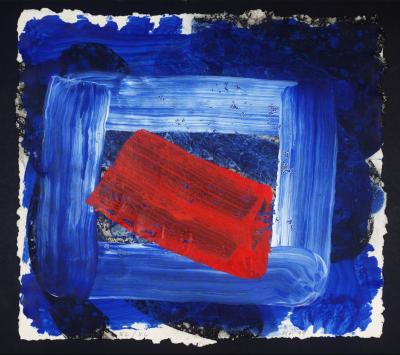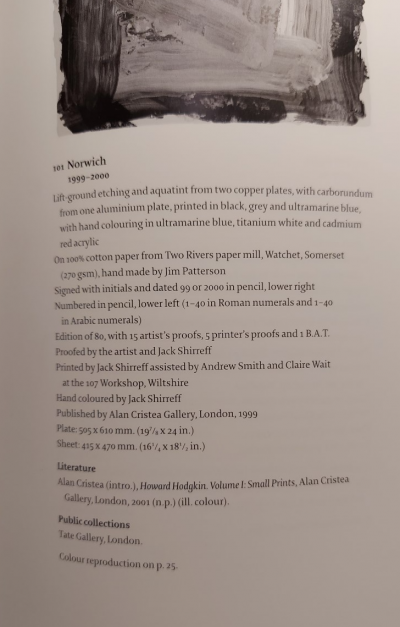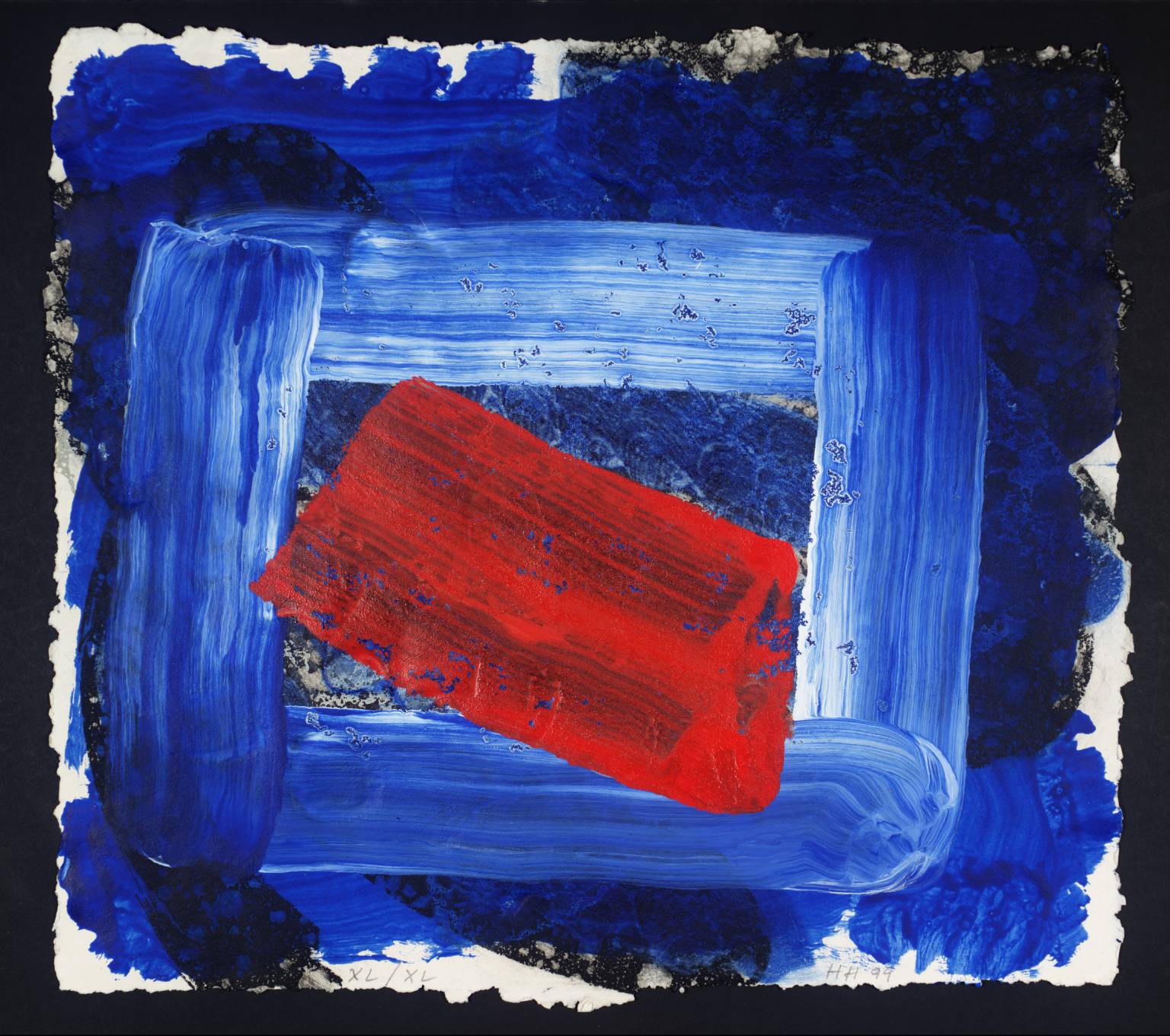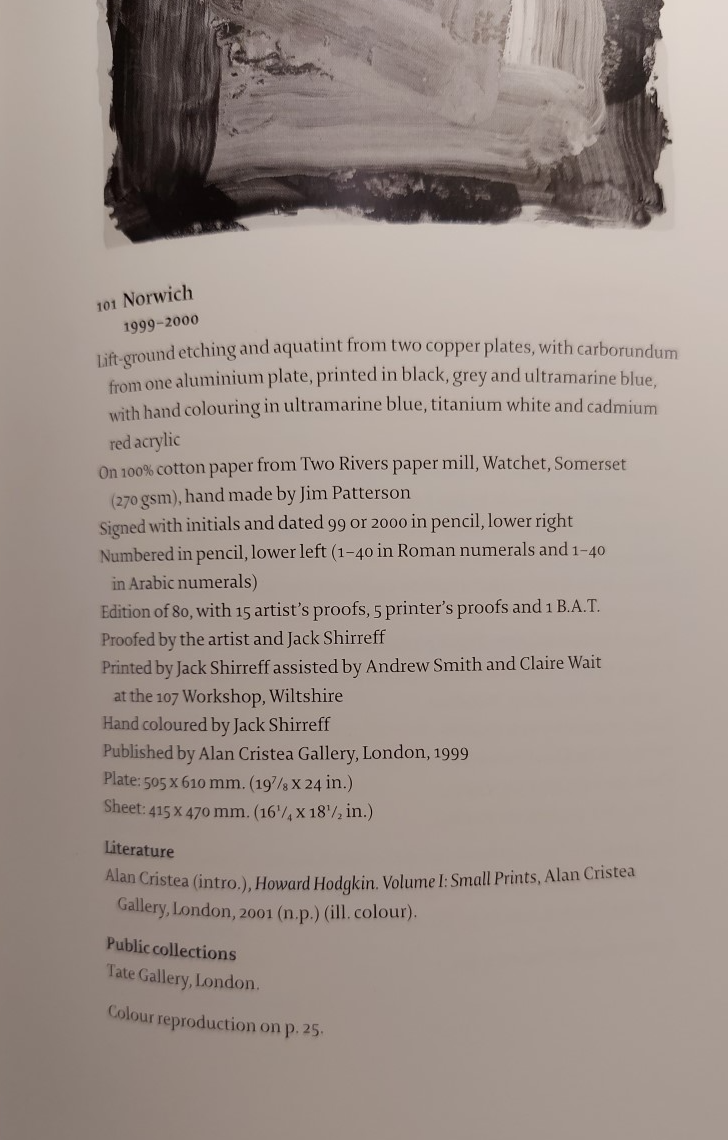Howard HODGKIN - NORWICH (1999) - Acquaforte originale a colori firmata, datata e giustificata in copie X/L
Howard Hodgkin
NORWICH (1999)
Acquaforte originale in colori firmata datata e giustificata in copie X/L
Formato dell'illustrazione 41 X 47 centimetri
Stampato da Jack Shirreff al 107 Workshop. Pubblicato da Alan Cristea Londra
Incorniciato da portare negli uffici di Plazzart 75019
oppure spedire in lastra, senza cornice, senza vetro
RIEPILOGO
Norwich è una stampa che doveva essere un regalo alla Elton John Aids Foundation, anche se nel caso la stampa non è stata distribuita. Fu pubblicato in un'edizione di quaranta e stampato da
Jack
Shirreff (nato nel 1943) al 107 Workshop, vicino a Bath in Inghilterra. La copia Tate è la numero quaranta nell'edizione. Hodgkin ha realizzato stampe dall'inizio degli anni '60 e lui e
Shirreff
hanno lavorato insieme per la prima volta nel 1990, quando ha prodotto una serie di stampe ispirate a viaggi esotici e poster di viaggio (Tate P20058-P20062). Ha lavorato di nuovo con Shirreff
nel
1995, producendo un'edizione di stampe intitolata Vedute veneziane (Tate P20166-P20169). Hanno sviluppato uno stretto rapporto di lavoro, stampando Shirreff e colorando a mano tutte queste
edizioni.
Norwich è una piccola immagine dai colori vivaci che evoca l'immediatezza gestuale dei quadri gemma di Hodgkin. Combina l'acquatinta e il carborundum, con la colorazione a mano di Shirreff.
Hodgkin
ha utilizzato un assistente per colorare a mano le sue stampe dalla fine degli anni '70, quando ha lavorato a Nick 1977 (Tate P77044) con Maurice Payne alla Petersburg Press. Da allora la
colorazione
a mano è diventata un aspetto integrante della tecnica di stampa dell'artista. Il processo di utilizzo di una lancetta dei "secondi" per colorare l'immagine stampata è stato in parte suggerito
dallo
storico dell'arte Herbert Read (1893-1968). Hodgkin ricorda di aver letto degli anonimi decoratori di ceramiche, e il ricordo ha influenzato la sua pratica. Tuttavia, non ricorda più la fonte
della
descrizione di Read. Secondo Hodgkin, l'artista è spesso tentato di alterare un'immagine attraverso successive reinterpretazioni. Al contrario, un assistente può essere impiegato, quasi come
uno
strumento meccanico, per duplicare i segni. L'"originale" di tali segni ripetuti a mano è sempre realizzato da un assistente sotto la stretta supervisione dell'artista. (Tutti i riferimenti
dall'intervista inedita di Tate.)
Bibliografia:
Catalogo ragionato ref 101
Dimensione :
- Altezza : 41 cm
- Larghezza : 47 cm
NORWICH (1999)
Acquaforte originale in colori firmata datata e giustificata in copie X/L
Formato dell'illustrazione 41 X 47 centimetri
Stampato da Jack Shirreff al 107 Workshop. Pubblicato da Alan Cristea Londra
Incorniciato da portare negli uffici di Plazzart 75019
oppure spedire in lastra, senza cornice, senza vetro
RIEPILOGO
Norwich è una stampa che doveva essere un regalo alla Elton John Aids Foundation, anche se nel caso la stampa non è stata distribuita. Fu pubblicato in un'edizione di quaranta e stampato da
Jack
Shirreff (nato nel 1943) al 107 Workshop, vicino a Bath in Inghilterra. La copia Tate è la numero quaranta nell'edizione. Hodgkin ha realizzato stampe dall'inizio degli anni '60 e lui e
Shirreff
hanno lavorato insieme per la prima volta nel 1990, quando ha prodotto una serie di stampe ispirate a viaggi esotici e poster di viaggio (Tate P20058-P20062). Ha lavorato di nuovo con Shirreff
nel
1995, producendo un'edizione di stampe intitolata Vedute veneziane (Tate P20166-P20169). Hanno sviluppato uno stretto rapporto di lavoro, stampando Shirreff e colorando a mano tutte queste
edizioni.
Norwich è una piccola immagine dai colori vivaci che evoca l'immediatezza gestuale dei quadri gemma di Hodgkin. Combina l'acquatinta e il carborundum, con la colorazione a mano di Shirreff.
Hodgkin
ha utilizzato un assistente per colorare a mano le sue stampe dalla fine degli anni '70, quando ha lavorato a Nick 1977 (Tate P77044) con Maurice Payne alla Petersburg Press. Da allora la
colorazione
a mano è diventata un aspetto integrante della tecnica di stampa dell'artista. Il processo di utilizzo di una lancetta dei "secondi" per colorare l'immagine stampata è stato in parte suggerito
dallo
storico dell'arte Herbert Read (1893-1968). Hodgkin ricorda di aver letto degli anonimi decoratori di ceramiche, e il ricordo ha influenzato la sua pratica. Tuttavia, non ricorda più la fonte
della
descrizione di Read. Secondo Hodgkin, l'artista è spesso tentato di alterare un'immagine attraverso successive reinterpretazioni. Al contrario, un assistente può essere impiegato, quasi come
uno
strumento meccanico, per duplicare i segni. L'"originale" di tali segni ripetuti a mano è sempre realizzato da un assistente sotto la stretta supervisione dell'artista. (Tutti i riferimenti
dall'intervista inedita di Tate.)
Bibliografia:
Catalogo ragionato ref 101
Dimensione :
- Altezza : 41 cm
- Larghezza : 47 cm
Questa descrizione è stata tradotta automaticamente. Clicca qui per vedere la versione originale FR
Venduto
"Questo lotto non è disponibile. Clicca su ""Vedi il catalogo"" per vedere lotti simili in vendita."
Consegna France:
48.00 € Tasse incluse. (*)
Prezzi per paese, clicca su Vedi
Visualizza
Hotline
Non esitate a chiamarci per qualsiasi richiesta
Altri articoli nella categoria « Howard Hodgkin »





